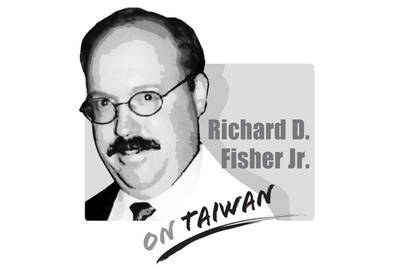The rise of China as a major economy and military power has been a major development this century. While China’s economic clout is felt across the world, it has also been aggressively pursuing a military modernization program.
One study published by the Washington-based Center for Strategic and International Studies in May last year said that since 2016, China’s annual defense budget has been 7.2 to 8.1 percent of total government spending.
Although China has projected its rise as peaceful, the truth is that Beijing has begun to redefine the power structure in Asia in its favor, leading some international relations experts to argue that its rise must be seen in the historical context of the rise and fall of great powers.
For a long time in the post-Cold War era, the US had the illusion of China’s peaceful rise. Only during the administration of former US president George W. Bush did Washington began to view China as a major strategic competitor.
The administration of his successor, Barack Obama, after failing to convince China to work together in managing global and regional affairs under the “Group of Two,” also redirected its efforts to retain its leadership role in the region through its Asia pivot policy.
Under former US president Donald Trump, the US launched a trade dispute against China and also initiated efforts to strengthen a strong relationship with its allies and partners through its “free and open Indo-Pacific” strategy, with the aim to retain its sole super-power status in the region.
Of course, the change in the US’ approach toward China has been driven by several factors including China’s increasing control over the South China Sea, improved ties between Beijing and Moscow, the Chinese communist government’s support of Iran and North Korea, its aim to become a major space power, its increased threat to Taiwan, and its attempt to subvert liberal international institutions.
Consequently, China’s moves, coupled with an increasing trade surplus with the US, have challenged the US’ position in Asia and beyond.
However, there is a growing sentiment among US security officials and experts that, given the US’ economic conditions as well as its security commitments in the Middle East and elsewhere, it is not possible for the US alone to ensure peace and security in the Asia-Pacific region, and contain China’s assertive posturing.
There is also an emerging understanding in the strategic circle in Washington that unilateral actions against China could not garner much support from other regional powers, as they are aiming to promote a multipolar order in the Indo-Pacific.
In this context, successive US presidents since Bush have deliberately invested in transforming ties with rising powers like India to develop a strong and unchallenged balance of power can against China.
Thus, while the Obama administration designated India as a major defense partner, the Trump administration placed India at the center of its regional strategy and changed the name of the “US Pacific Command” to the “US Indo-Pacific Command,” largely in the recognition of India as a regional power.
Under the leadership of Indian Prime Minister Narendra Modi, New Delhi has indicated its desire to work with the US to promote freedom, security, openness, democracy and development in the region.
In turn, India and the US have taken a slew of measures to increase their security and defense relations.
India established an Indo-Pacific desk in its Ministry of External Affairs, and New Delhi and Washington have over the past four years signed three major bilateral defense agreements: the Logistics Exchange Memorandum of Agreement; the Communications, Compatibility and Security Agreement; and the Basic Exchange and Cooperation Agreement.
Also, for the first time since the 1962 Sino-Indian war, the US has strongly criticized China for intruding into Indian territory in the Ladakh region.
The Quadrilateral Security Dialogue has emerged as another forum for close collaboration between India and the US against China.
There are structural and practical reasons for India and the US to join hands against China.
For the US, a rising India conditioned by democratic values, the idea of freedom and the principle of coexistence is not seen as a threat to its leadership position in Asia. Given the size of India’s territory, population, economy, military, and its geographical proximity and historical border dispute with China, as well as its desire to emerge as a global player, Washington views New Delhi as the most suitable counterweight against Beijing.
Washington also views India’s Act East policy as compatible with its Indo-Pacific strategy.
India’s willingness to work with the US against China in the past few years has been another encouraging development for the US. For India, the relationship with China has largely remained fragile and tense, and Chinese President Xi Jinping’s (習近平) assertive posturing on the contested issue of the mutual border has only intensified its security concerns.
China’s support of Pakistan against India, and its efforts to foster a new nexus between China, Pakistan and Russia, and to develop a “string of pearls” against India through its Belt and Road Initiative have posed a multilayered challenge to India.
New Delhi is also concerned about China’s assertive posturing in the South China Sea, as about 50 percent of India’s imports and exports are shipped through the region.
However, it is also true that there is no match between China and India in terms of economic resources and military power.
Therefore, India needs to build a strong and robust partnership with the US to effectively contain China. India thinks that the presence of the US in South Asia would help maintain a balance of power in its favor. Without access to the US’ advanced weaponry and technology, India cannot modernize its military. The US’ changed policy toward Pakistan has also emboldened India to forge closer ties with Washington.
While the “China factor” has spurred profound bilateral cooperation between India and the US, the two sides have also taken calibrated moves to improve their relationship with Taiwan — which under the leadership of President Tsai Ing-wen (蔡英文) has emerged as an anchor of the “anti-China crusade.”
This in turn opens a new avenue for cooperation between Taipei, Washington and New Delhi.
While it becomes clear that the current phase of the triangular relationship is tilted toward India and the US, its future direction largely depends on US President Joe Biden’s China policy.
Sumit Kumar is a former Ministry of Foreign Affairs visiting fellow at National Chengchi University and a post-doctoral fellow at the Indian Council of Social Science Research.
Concerns that the US might abandon Taiwan are often overstated. While US President Donald Trump’s handling of Ukraine raised unease in Taiwan, it is crucial to recognize that Taiwan is not Ukraine. Under Trump, the US views Ukraine largely as a European problem, whereas the Indo-Pacific region remains its primary geopolitical focus. Taipei holds immense strategic value for Washington and is unlikely to be treated as a bargaining chip in US-China relations. Trump’s vision of “making America great again” would be directly undermined by any move to abandon Taiwan. Despite the rhetoric of “America First,” the Trump administration understands the necessity of

US President Donald Trump’s challenge to domestic American economic-political priorities, and abroad to the global balance of power, are not a threat to the security of Taiwan. Trump’s success can go far to contain the real threat — the Chinese Communist Party’s (CCP) surge to hegemony — while offering expanded defensive opportunities for Taiwan. In a stunning affirmation of the CCP policy of “forceful reunification,” an obscene euphemism for the invasion of Taiwan and the destruction of its democracy, on March 13, 2024, the People’s Liberation Army’s (PLA) used Chinese social media platforms to show the first-time linkage of three new

If you had a vision of the future where China did not dominate the global car industry, you can kiss those dreams goodbye. That is because US President Donald Trump’s promised 25 percent tariff on auto imports takes an ax to the only bits of the emerging electric vehicle (EV) supply chain that are not already dominated by Beijing. The biggest losers when the levies take effect this week would be Japan and South Korea. They account for one-third of the cars imported into the US, and as much as two-thirds of those imported from outside North America. (Mexico and Canada, while
I have heard people equate the government’s stance on resisting forced unification with China or the conditional reinstatement of the military court system with the rise of the Nazis before World War II. The comparison is absurd. There is no meaningful parallel between the government and Nazi Germany, nor does such a mindset exist within the general public in Taiwan. It is important to remember that the German public bore some responsibility for the horrors of the Holocaust. Post-World War II Germany’s transitional justice efforts were rooted in a national reckoning and introspection. Many Jews were sent to concentration camps not